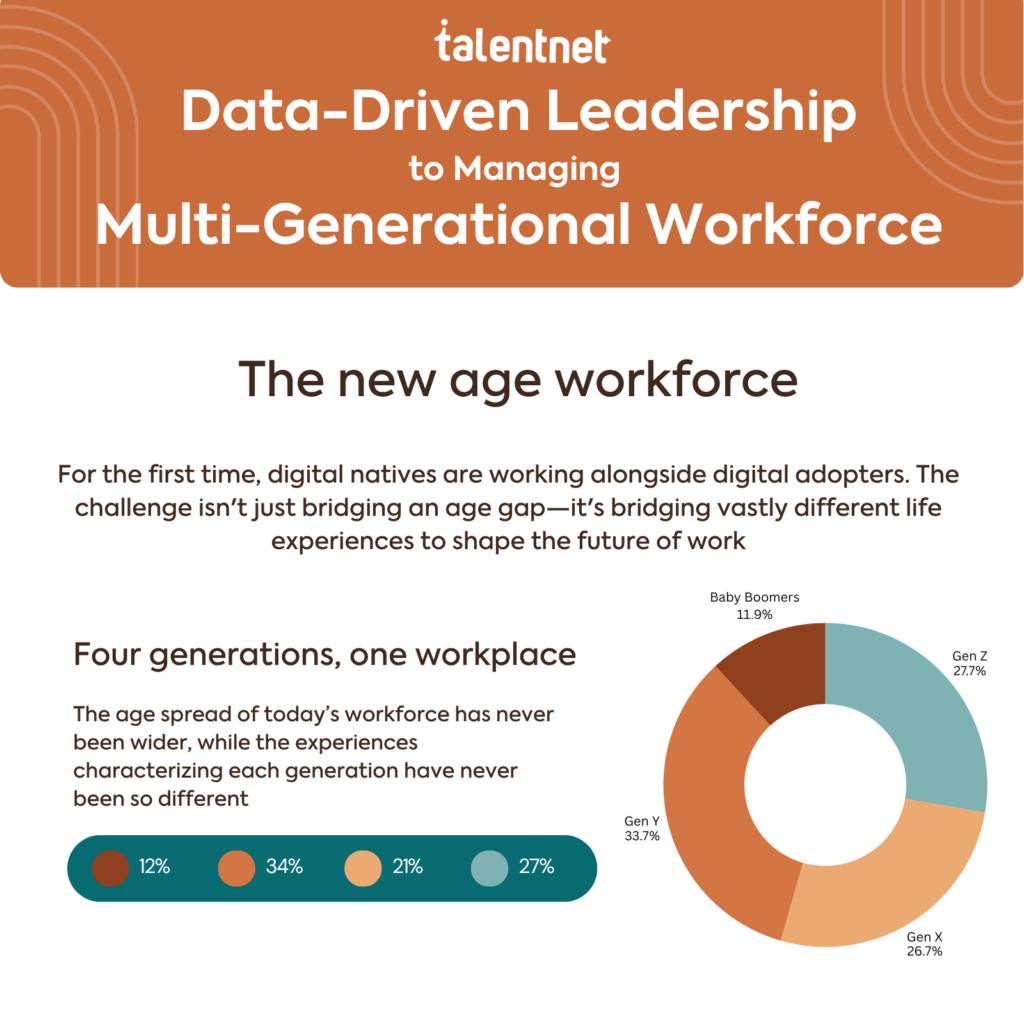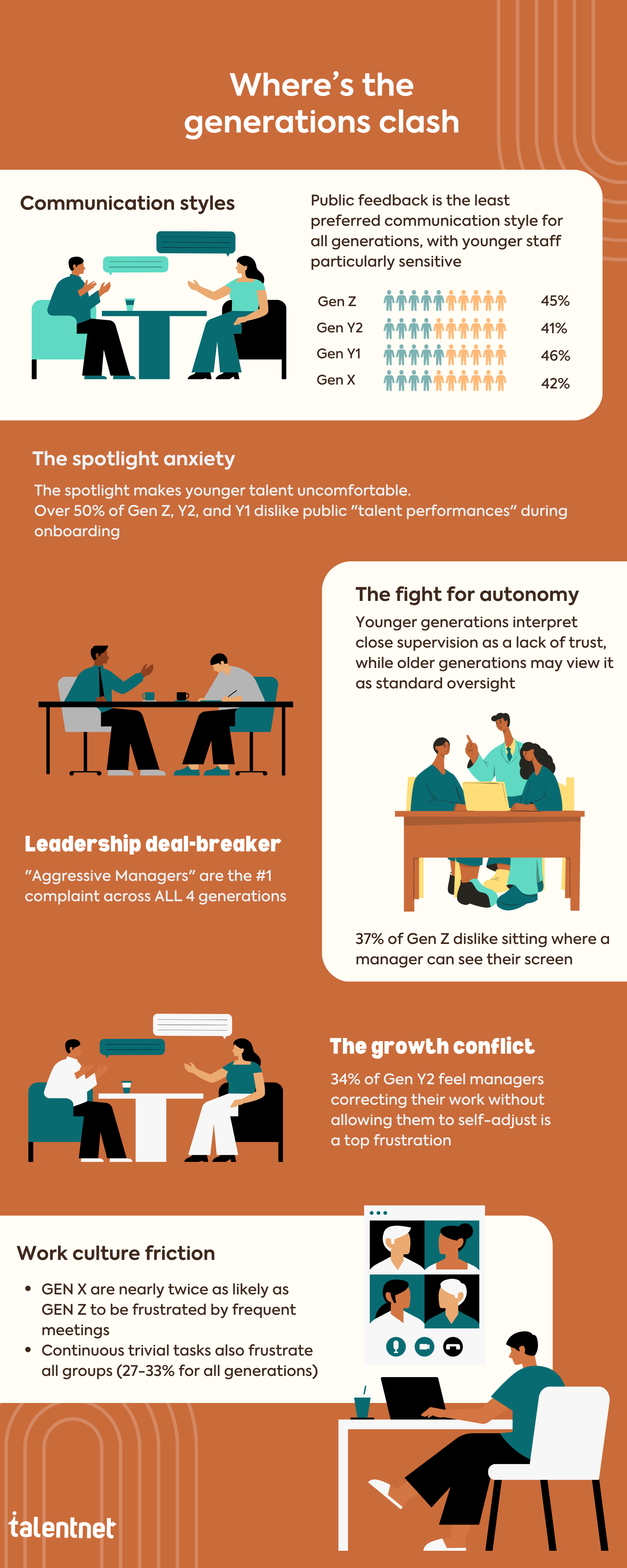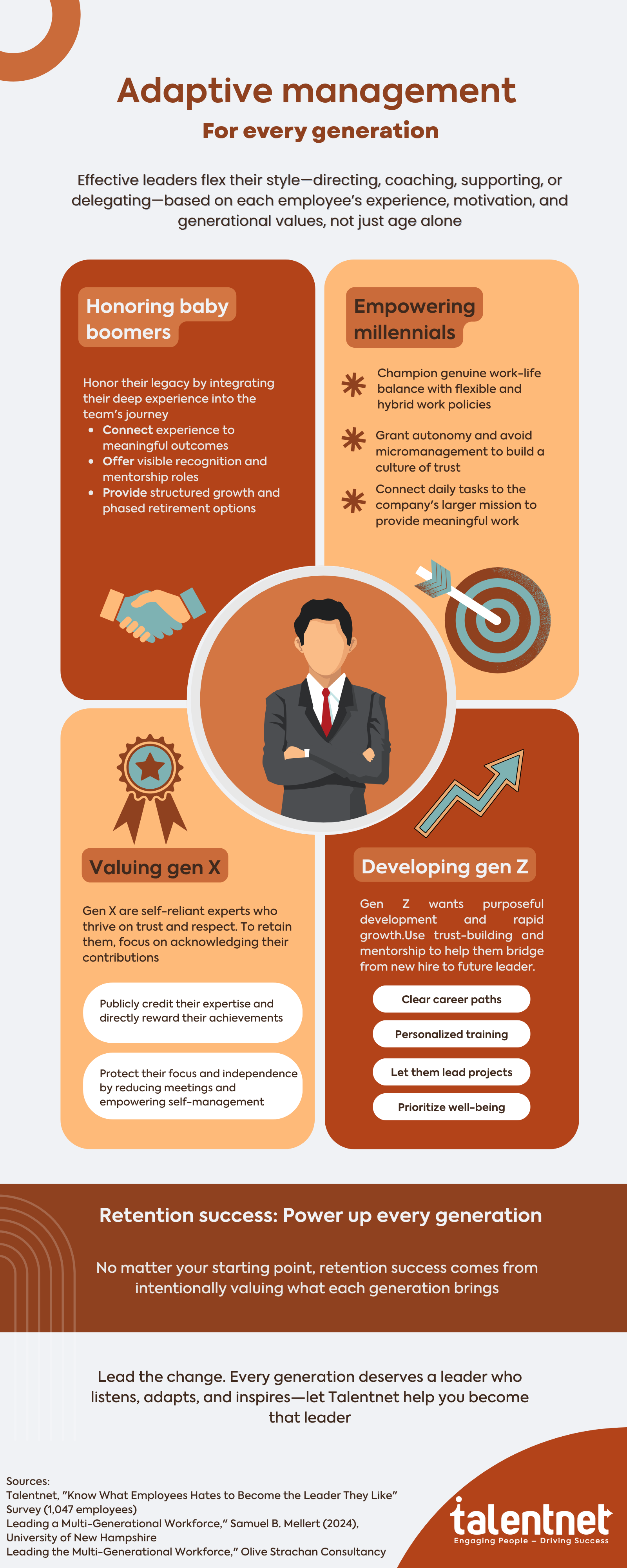Managing A Multigenerational Workforce: Data-Driven Guide

Oct 14, 2025
Last updated on Oct 14, 2025
Your company's greatest asset—its generational diversity—can also be its greatest hidden risk. Organizations that successfully leverage this diversity gain a significant competitive advantage through innovation and enhanced problem-solving; those that don't face friction, disengagement, and turnover.

Key Takeaways
- A multigenerational workforce brings competitive advantages through diverse perspectives and innovation, but requires deliberate leadership strategies to prevent friction and disengagement.
- Data reveals that aggressive, authority-driven management alienates 43% of Gen Y and 41% of Gen Z employees, while excessive meetings disproportionately frustrate Gen X workers.
- Communication and feedback mismatches—not just technological differences—are the primary sources of generational tension, with public feedback being universally uncomfortable but particularly damaging to younger employees.
- Adaptive leadership that flexes between directing, coaching, supporting, and delegating based on individual and generational needs transforms management from a friction point into a growth catalyst.
A multigenerational workforce, where up to five generations with vastly different communication styles, technological fluencies, and work expectations collaborate, is the new reality. These organizations face inevitable challenges like communication gaps and misaligned values, but effective leadership can transform these differences into strategic advantages by moving beyond stereotypes and using data to build inclusive, high-performing teams.

Generational clashes represent more than minor workplace irritations. They are measurable friction points that directly erode productivity, damage culture, and drive costly turnover. Identifying these hidden tensions requires systematic employee engagement measurement to understand where generational preferences diverge. The root causes extend beyond surface-level differences in technology adoption to fundamental disagreements about communication, authority, and the very purpose of work itself.
The way information flows through your organization is shaped by generational preference, and the mismatch creates daily inefficiencies. Older generations prioritize face-to-face interaction and phone calls, viewing them as more personal and trustworthy. Younger employees gravitate toward instant messaging and digital tools, valuing speed and documentation. This preference gap becomes critical in feedback delivery. Public feedback—whether in team meetings or open forums—registers as the least preferred method across all generations. For Gen Z and Millennials, however, it creates genuine anxiety that undermines psychological safety and engagement. When managers default to public critique, they inadvertently signal a lack of respect for younger employees’ need for tactful, private communication. The misunderstanding between team leaders and Gen Z employees often stems from these fundamental communication style differences that create unintended friction.
Traditional management relied on visible supervision to ensure accountability. Today, that approach backfires with younger generations who interpret close oversight as a fundamental breach of trust. The data is striking: 37% of Gen Z employees actively dislike visual monitoring. For them, autonomy is not a workplace perk or a reward for tenure—it is a baseline expectation for engagement. This creates a direct clash with hierarchical management cultures where control and visibility are equated with diligence. Building trust in the workplace requires leaders to reconsider traditional oversight models and embrace transparency over surveillance.
The most significant generational divide may be in how employees respond to leadership itself. Authority-driven, fear-based management is rapidly losing effectiveness. Research from Talentnet of what employees hate to become the leader they like shows that 43% of Gen Y and 41% of Gen Z identify aggressive managers as their single most unpleasant workplace trait. These generations do not respond to top-down directives or intimidation tactics. They seek inspiration, empathy, and participative decision-making. When leaders continue to rely on positional authority alone, they alienate the very employees they need to retain.
A fundamental tension exists around how time should be spent during work hours. Gen X, shaped by efficiency-driven cultures, views excessive meetings as a productivity killer. Half of Gen X employees cite too many meetings as a top workplace distraction, compared to only 30% of Gen Z. This gap reveals competing definitions of work: one generation values focused execution, while another may still associate presence—particularly in meetings—with commitment. In Vietnam, where 46% of manufacturing firms report generational shifts as a major challenge, this friction is especially acute. Leaders who fail to address meeting culture risk burning out their most experienced workers while inadvertently favoring practices that younger employees tolerate but older employees find exhausting.

How do you adapt your leadership to unlock every generation’s potential?
The solution to generational conflict is not a universal policy applied uniformly. It is an adaptive leadership mindset that recognizes each generation’s distinct motivations and adjusts accordingly. Effective leaders do not manage everyone the same way; they flex between directing, coaching, supporting, and delegating to meet the unique needs of each employee.
Baby Boomers are motivated by stability, recognition for decades of service, and the opportunity to pass on hard-won institutional knowledge. They have witnessed entire business cycles and carry wisdom that cannot be replicated through training programs. Honor their experience by creating formal mentorship roles where they guide younger employees. Offer tangible rewards—public recognition, legacy projects, or advisory positions—that acknowledge their loyalty and contributions. Provide phased retirement options that allow them to transition gracefully while continuing to add value. Developing next generation leaders requires leveraging this institutional knowledge through structured knowledge transfer programs.
Millennials thrive when they feel trusted and understand how their work contributes to something larger than immediate tasks. They do not respond well to micromanagement or bureaucratic oversight. Empower them by granting genuine project ownership and the autonomy to execute without constant check-ins. Most importantly, connect their daily responsibilities to the company’s mission and broader impact. Millennials seek meaning in their work, and leaders who can articulate that connection will unlock exceptional commitment and creativity.
Gen X employees are self-reliant experts who value competence and independence above formal recognition. They do not need constant feedback or public praise; they need respect for their time and expertise. Value them by:
- Protecting their focus time and reducing unnecessary meetings that fragment their day
- Implementing fair and frequent feedback through structured performance appraisals that are direct and constructive without being performative
- Acknowledging their expertise publicly when appropriate, but avoiding infantilizing oversight
- Trusting them to deliver results without micromanagement
Gen Z seeks purposeful development, rapid skill growth, and an environment that prioritizes their total well-being. They evaluate employers not just on salary, but on career trajectory and values alignment. With 86% of Gen Z candidates citing diversity as a top commitment criterion and 72% wanting to expand digital skills, the message is clear: they want to grow, and they want to belong. Understanding what truly motivates Gen Z in modern workplaces helps leaders design development programs that resonate. Develop them by providing transparent career paths, personalized training programs, and opportunities to lead meaningful projects early in their tenure. Champion their wellness through flexible work arrangements and psychological safety to prevent burnout in younger employees. For Gen Z, these are not perks—they are core retention strategies that determine whether they stay or leave.

Managing a multigenerational workforce is not about accommodating differences—it is about strategically leveraging them. Leaders who use data to understand generational friction points and adapt their management style accordingly will build resilient, high-performing organizations. The competitive advantage lies not in eliminating generational diversity, but in mastering it. Talentnet’s HR consulting services help CEOs transform generational complexity into sustainable growth.

Thank you for your interest in our services.
Kindly check your mailbox to get the document.

Solve your HR problems!
6th Floor, Star Building, 33 Mac Dinh Chi, Saigon Ward, Ho Chi Minh city, Vietnam




